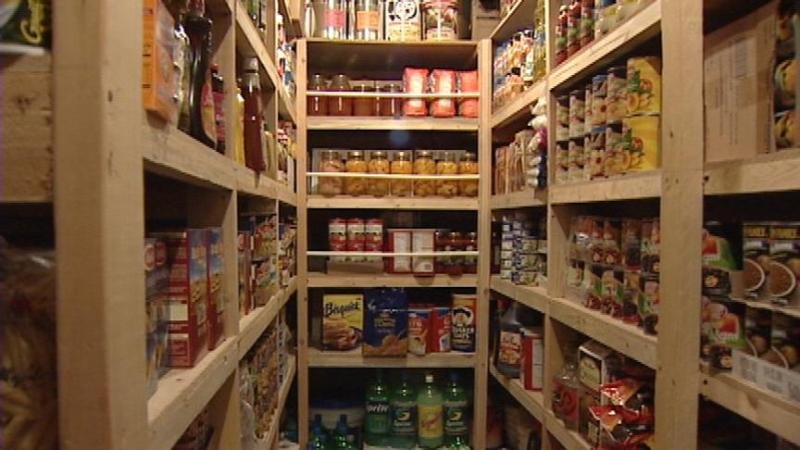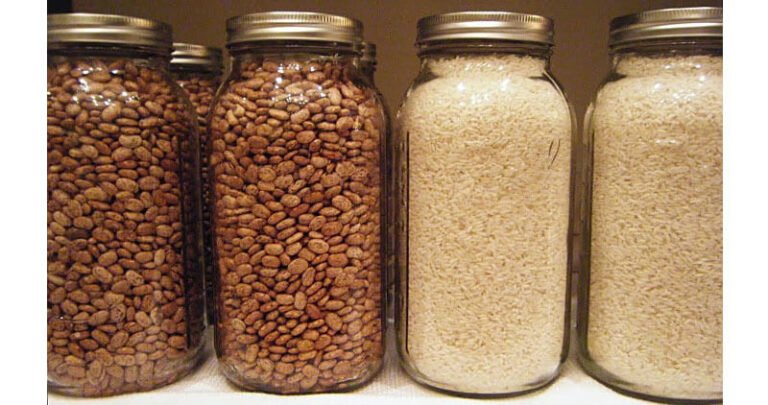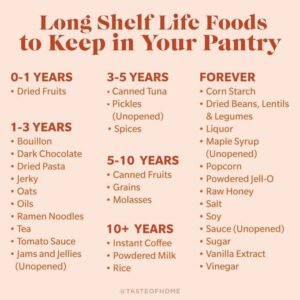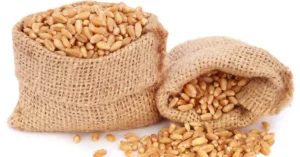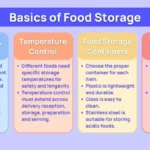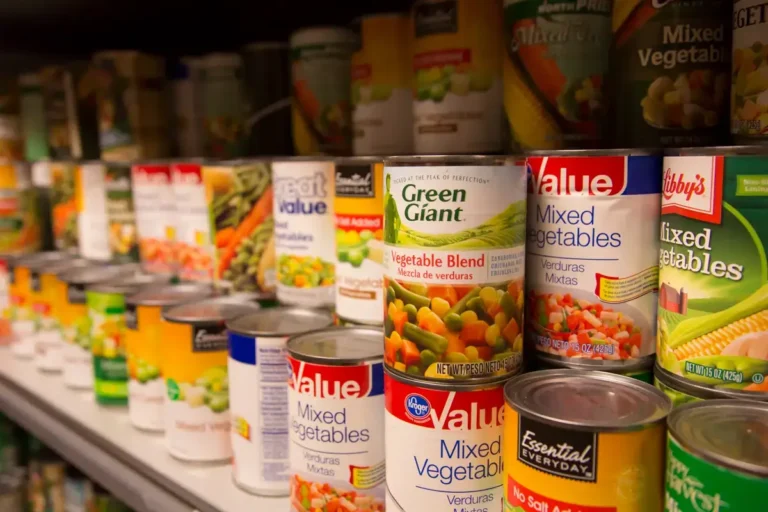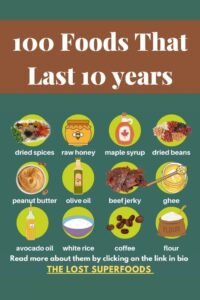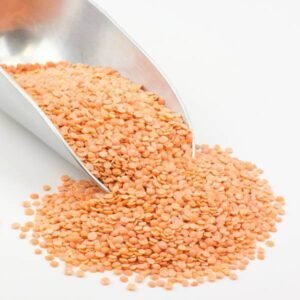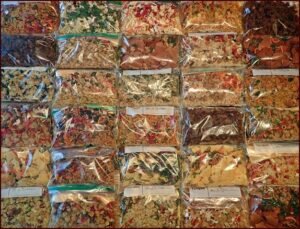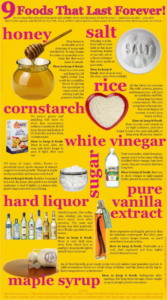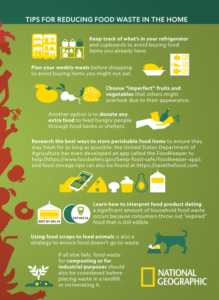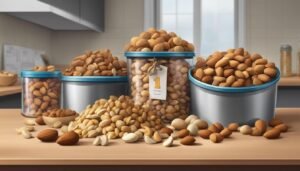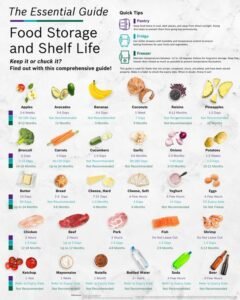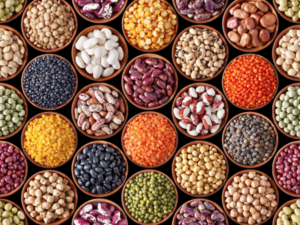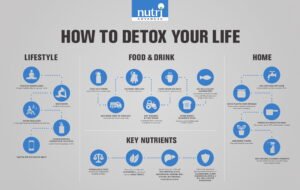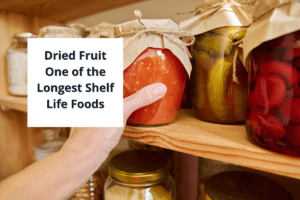Ever wondered what foods you should prep for long-term storage? In today’s world, long-term food storage isn’t just a trend but a necessity. From natural disasters to unpredictable events, being prepared can bring peace of mind and security. I’ve put together a comprehensive guide to the best foods to keep your pantry stocked and your family nourished. You’ll find out which grains, meats, fruits, and vegetables provide the most value for long-term storage. Ready to learn how to build a pantry that stands the test of time? Let’s get started on ensuring your food supply is both practical and cost-effective while covering all your nutritional needs.
Post Contents
ToggleEssential Grains for Long-Term Storage
When it comes to long-term storage of food, choosing the right grains can make all the difference. Grains have been a staple in diets across cultures and centuries, offering both versatility and nutritional benefits. Below, we’ll explore two essential grains: rice and wheat, their benefits, and the best ways to store them.
.
Rice: A Staple for Longevity
Rice is one of the easiest grains to store for long periods. But not all rice is created equal. Here’s a quick rundown on the differences between brown and white rice:
- Brown Rice: This type has the bran layer intact, making it more nutritious but also more prone to spoilage due to the oils in the bran.
- White Rice: This has a much longer shelf life because the bran layer is removed. It’s less nutritious than brown rice but lasts longer and is easier to store.
To make the most out of your rice storage, follow some best practices:
- Store in mylar bags: These keep air and light out, extending the shelf life.
- Add oxygen absorbers: These packets prevent oxidation, keeping the rice fresh.
- Keep in a cool, dark place: Ideal storage conditions will ensure your rice remains safe and edible for years.
Cooking with rice is simple and it pairs well with almost any dish. Fry it, boil it, or use it as an ingredient in soups and stews; rice remains a highly versatile food in your pantry.
Wheat: Long-Term Storage Nutritional Powerhouse
Wheat, especially in its whole form like wheat berries, is incredibly versatile and packed with nutrients. You can grind it into flour for baking or cook it whole for a chewy, nutritious snack.
Whole grains have significant benefits:
- Nutrient-packed: They contain bran, germ, and endosperm, making them rich in fibre, vitamins, and minerals.
- Versatile uses: You can make bread, pasta, or even use it in hearty soups.
Proper storage methods are key to keeping your wheat durable and nutritious:
- Use food-grade buckets: These are airtight and help prevent contamination.
- Include oxygen absorbers: Like with rice, these help to keep your wheat fresh.
- Store in a cool, dark place: Minimising exposure to heat and light is crucial for long-term storage.
Wheat berries can easily be milled into flour using a home mill, allowing you to enjoy freshly-baked goods that are much healthier than store-bought flour, which loses nutrients quickly after being ground.
In conclusion, both rice and wheat are crucial for any long-term food storage plan. They provide essential nutrients and have multiple culinary uses, making them top choices for anyone aiming to be prepared for any scenario.
Canned Foods: Convenience and Longevity
Canned foods have long been a staple for those of us looking to build a robust long-term storage plan. Their convenience and longevity make them indispensable. Simply pull the tab, heat, and you have a meal ready to go. Let’s dive into how you can turn canned vegetables and fruits into essentials for your pantry.
Vegetables: Nutrient-Rich and Versatile
Canned vegetables are a powerhouse in any long-term food storage plan. Not only do they hold onto their nutritional value, but they’re also incredibly versatile in the kitchen.
Best vegetables for canning:
- Green Beans: Packed with vitamin C and fibre, canned green beans are a fantastic side dish or can be transformed into casseroles and salads.
- Carrots: These are rich in beta-carotene, which the body converts into vitamin A. They add a touch of sweetness and colour to stews and soups.
- Peas: Canned peas maintain a good level of vitamin K and antioxidants. They are perfect for quick salads or adding to pot pies.
- Spinach: High in iron and calcium, canned spinach can be added to everything from smoothies to quiches.
- Corn: Vitamin-rich and sweet, canned corn can be a simple side or stirred into chilli.
Selecting quality canned goods:
- Check labels: Look for vegetables canned in water with no added salts or sugars.
- Avoid dents: Cans with dents, especially around the seams, can compromise the safety of the food.
- Expiry dates: Ensure a long shelf life by selecting cans with the latest expiry dates.
Keeping a variety of these canned vegetables not only provides nutritional benefits but also ensures you never run out of essential ingredients to mix up your meals.
For a comprehensive guide to canning and preservation click here
Fruits: Natural Sweeteners for Your Pantry
Fruit is necessary not only because they taste great, but also because they are packed with essential vitamins and minerals that are crucial for a balanced diet. Canned fruits can be both a healthy snack and a base for many recipes.
Advantages of canned fruits:
- Vitamins and Minerals: Canned fruits often retain a significant amount of their original nutrient profile. Vitamin C, fibre, and important antioxidants can be found in nearly every can.
- Variety: Having a range of fruits ensures diversity in your diet. Think apples, peaches, pears, and even exotic fruits like pineapples.
- Convenience: They can be eaten right out of the can, added to yoghurts or cereals, and used in baked goods.
Some top choices for long-term storage:
- Peaches: Full of vitamin C and fibre, peaches can be used in desserts or simply enjoyed alone.
- Pineapple: High in vitamin C and manganese, pineapple is great in salads and stir-fries.
- Applesauce: A good source of fibre and perfect for baking or as a healthy snack.
- Pears: Vitamin C and fibre-rich, great with cheese or on their own.
Selecting the right canned fruits:
- Packaging: Opt for fruits canned in their juices rather than syrup to avoid extra sugar.
- Integrity: As with vegetables, the integrity of the can is crucial for safety.
- No added preservatives: Choose brands that refrain from using artificial preservatives.
By focusing on the right canned vegetables and fruits, you’re ensuring that your long-term food storage isn’t just about survival, but also about thriving. Having these nutrient-rich resources at your disposal can make a world of difference. For further insight on long-term food safety, check out this comprehensive guide on food canning.
Legumes: Protein-Packed Essentials
When it comes to long-term food storage, legumes are a staple you can’t overlook. They’re packed with protein, vitamins, and offer a shelf life that can extend for years when stored correctly. Two of the most vital types of legumes you should consider are beans and lentils. Let’s dive into why they are so essential and how to properly prepare and store them.
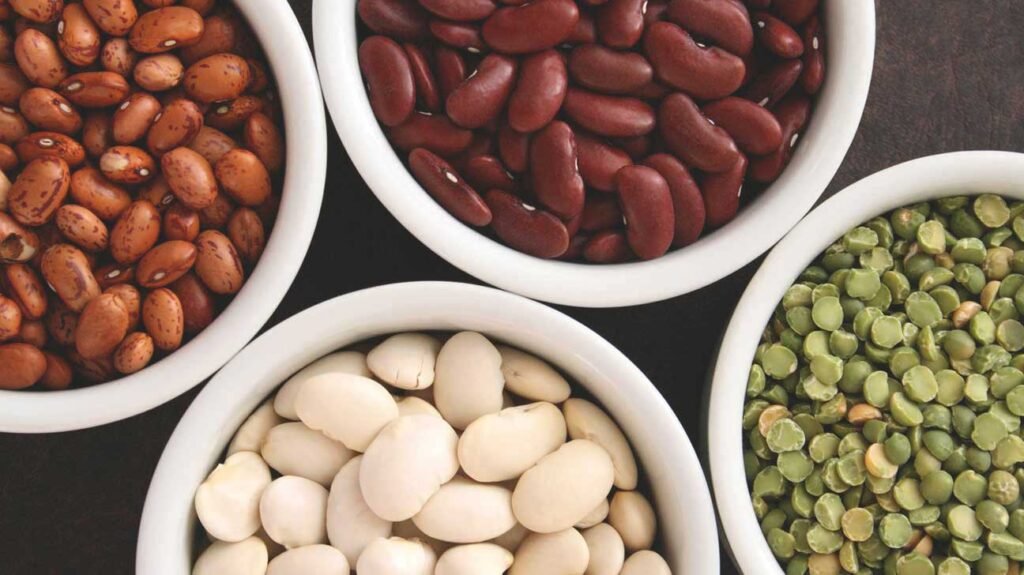

Beans: Versatile Protein Sources
Beans are incredibly versatile and a fantastic source of plant-based protein. They’re available in several varieties, each offering unique flavours and textures. Some popular types of beans include:
- Black Beans: Great for soups, stews, and a variety of chilli recipes.
- Kidney Beans: Frequently used in salads and chilli.
- Pinto Beans: Excellent for refried beans and burritos.
- Chickpeas: Perfect for making hummus and adding to salads.
To prepare and enjoy these beans, they typically need to be soaked before cooking. This not only reduces cooking time but also makes them easier to digest. Here’s a simple soaking method:
- Overnight Soaking: Place beans in a large bowl, cover with water and let them sit overnight.
- Quick Soak: Boil the beans for 2 minutes, take them off the heat, and let them soak in the hot water for an hour.
Storage-wise, the best way to ensure they last is by keeping them in a cool, dry place in airtight containers. Properly stored beans can last several years. According to National Centre for Home Food Preservation, dried beans can maintain quality for up to two years and retain their nutrient content even longer.
Lentils: Quick-Cooking Nutrition
Lentils are beloved for their quick cooking times and their rich nutritional content. Compared to other legumes, they cook pretty fast, saving you both time and energy. Different types of lentils you can integrate into your long-term food storage include:
- Green Lentils: Retain their shape well and are perfect for salads and side dishes.
- Red Lentils: Cook quickly and turn mushy, making them great for soups and stews.
- Brown Lentils: Versatile and commonly used in a variety of dishes.
What sets lentils apart is their ease of use. Unlike many other legumes, they don’t need to be soaked before cooking. Just a quick rinse to remove any dust, and you’re ready to go. They also cook within 15-30 minutes, making them a superb option for quick meals. Nutritionally, lentils are a powerhouse, delivering high amounts of protein, fibre, and essential vitamins.
In terms of storage, the key is keeping them in an airtight container in a cool, dry spot. This way, lentils can easily last for up to a year or more. Sites like Food Storage Moms offer detailed tips on how to extend their shelf life if you need more information.
In conclusion, incorporating a variety of legumes into your long-term food storage not only ensures that you have access to crucial nutrients but also provides you with versatile ingredients that can be used in numerous culinary applications. Whether you prefer beans or lentils, both are must-haves for anyone looking to maintain a well-balanced food storage.
Dehydrated Foods: Lightweight and Long-Lasting
Dehydrated foods are a fantastic option for long-term food storage due to their extended shelf life and lightweight nature. They retain much of their nutritional value and are highly versatile. So, whether you’re prepping for an emergency or just aiming for a more self-sufficient lifestyle, dehydrated foods are a must-have.
Fruits and Vegetables: Nutrient Preservation
Dehydrating fruits and vegetables helps lock in nutrients for the long haul. They are easy to store and rehydrate, making them very practical. Some of the best fruits and vegetables to dehydrate include:
- Apples: Slice them thinly before dehydrating. Store in airtight containers to keep them crisp. Rehydrate them by soaking in warm water for a few hours.
- Bananas: Dehydrate banana slices until they are crispy. They can be rehydrated by placing them in a bowl of water for about 30 minutes.
- Carrots: Shred or slice before dehydrating. Store in glass jars or vacuum-sealed bags. Rehydrate by soaking in hot water for 15-20 minutes.
- Peppers: Slice into strips and dehydrate. These can be used directly in soups or stews without rehydration.
- Tomatoes: Slice, dehydrate, and store in an airtight jar. Rehydrate by soaking in warm water for about 30 minutes or use them directly in cooking.
To store these dehydrated foods effectively, keep them in cool, dry areas away from sunlight. Using Mylar bags with oxygen absorbers can extend their shelf life exponentially. When it’s time to rehydrate, just use these simple methods depending on the food, and you’ll have vibrant, nutrient-packed ingredients at your fingertips.
Helpful link for more dehydrating tips: Dehydrating Vegetables Guide
Herbs and Spices: Enhancing Flavour
Herbs and spices play a crucial role in long-term food storage. They provide flavour to otherwise bland meals and offer various health benefits. Some essential herbs and spices to consider:
- Basil: Perfect for a variety of dishes, it retains much of its flavour when dehydrated.
- Oregano: Excellent for Italian dishes, its strong flavour persists well through drying.
- Thyme: Adds depth to soups and stews. It also has antimicrobial properties.
- Parsley: A versatile herb that can brighten up any dish, giving it a fresh taste.
- Rosemary: Ideal for meat dishes, it has a long shelf life when dehydrated.
- Garlic Powder: Essential for countless recipes. Dehydrate garlic cloves and grind into powder.
Storing dehydrated herbs? It’s simple. Keep them in airtight jars or use a vacuum sealer. Store in a cool, dark place to retain their potency.
For rehydration, most herbs don’t need pre-soaking. They can be added directly to simmering dishes, allowing their flavours to release gradually. Remember, a pinch can go a long way in making a meal delightful.
Useful link for storing herbs and spices: How to Store Dried Herbs
By incorporating these tips, you can have a diverse and flavourful set of food options ready to go, enhancing both your emergency preparedness and everyday cooking.
Nuts and Seeds: Healthy Fats for Your Pantry
When preparing for long-term food storage, including nutrient-dense and energy-rich foods like nuts and seeds is a smart move. These foods are not only versatile and delicious, but they also provide essential healthy fats and proteins crucial for maintaining a balanced diet. Let’s explore why nuts and seeds deserve a spot in your pantry and how to best store them.
Nuts: A Source of Energy
Nuts are a fantastic addition to your long-term food pantry due to their high energy content and nutrient profile. They are rich in essential fats, protein, and other vital nutrients that help sustain energy levels. Here’s a closer look at some popular nuts and their benefits:
- Almonds: Packed with Vitamin E, magnesium, and fibre, almonds are great for heart health and can boost your energy.
- Walnuts: These are excellent sources of Omega-3 fatty acids, which are beneficial for brain health.
- Pistachios: High in protein and antioxidants, pistachios support metabolic health.
- Peanuts: Economical and rich in B vitamins, protein, and healthy fats, peanuts are also zero cholesterol foods.
To keep nuts fresh for the long term, it’s essential to store them properly. Follow these tips:
- Airtight Containers: Use airtight containers to prevent exposure to oxygen which can cause rancidity.
- Cool, Dark Place: Store nuts in a cool, dark pantry, or even better, keep them in the refrigerator or freezer for longer shelf life.
- Dry Environment: Ensure the storage area is dry to prevent mould growth.
For more on which nuts to include, check out this guide on selecting healthy, long-lasting nuts for your pantry.
Seeds: Versatile and Nutrient-Dense
Seeds like chia and flaxseed are exceptionally nutrient-dense and can be used in many meals making them versatile pantry staples. They are excellent sources of Omega-3 fatty acids, fibre, and protein, which contribute to overall well-being.
- Chia Seeds: These tiny seeds are incredibly high in fibre and Omega-3s. They also contain various vitamins and minerals.
- Flaxseeds: Rich in lignans and Omega-3s, flaxseeds support digestive health and have antioxidant properties.
- Pumpkin Seeds: Packed with manganese, magnesium, and zinc, pumpkin seeds can bolster immune function.
- Sunflower Seeds: These are great for an energy boost and are also high in Vitamin E and selenium.
Storing seeds effectively helps maintain their nutritional value and prevents spoilage. Here’s how:
- Opaque Containers: Store seeds in opaque containers to shield them from light, which can degrade oils.
- Cool Storage: Similar to nuts, keeping seeds in a refrigerator or a cool, dry place will prolong their freshness.
- Vacuum Sealing: For even longer storage, consider vacuum sealing to keep out moisture and air.
For further insights on storing seeds, the American Heart Association offers great advice and nutritional information.
Integrating nuts and seeds into your long-term food storage strategy can provide you with essential nutrients and variety in your diet. Always choose quality over quantity and pay attention to storage methods to ensure these healthy fats remain in optimal condition for as long as possible.
Stay tuned for more valuable tips on stocking your pantry with the best long-term storage foods!
Conclusion
Stocking up on the best foods for long-term storage ensures you’re prepared for any situation. Grains, canned meats, dried beans, and preserved fruits and vegetables offer a great mix of nutrition and shelf life. Building a versatile pantry is a smart move that saves both time and money.
Start your own long-term food storage today. Planning now brings peace of mind for future uncertainties. Plus, you’ll enjoy the satisfaction of homemade, stored goods.
Thank you for reading. I’d love to hear your thoughts and experiences with long-term food storage. Share them in the comments below!

